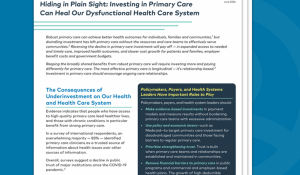You are looking at an archived version of our site. Please visit thepcc.org for a fresh, new experience!
You are here: Array » Pharmaceutical Giant P ...
Pharmaceutical Giant Puts Medical-Home Concept to the Test
By Given its focus on research, it shouldn't be surprising that GlaxoSmithKline doesn't accept a premise at face value. Instead, the London-based pharmaceutical giant wants to verify for itself that a relatively new collaborative model for providing primary care services could result in better health outcomes for employees and lower health insurance premiums for the company. The medical home concept puts patients under the care of a team of doctors, nurses and other health care professionals who are paid extra to actively manage a person's health and health care. In January 2012, GlaxoSmithKline began allowing its North Carolina employees to receive primary care services through a relatively new concept known as patient-centered medical homes as part of a two-year pilot program.
A patient-centered medical home puts the focus on preventive medicine and better care for chronic illnesses, says Andrew Webber, president and CEO of the National Business Coalition on Health, a not-for-profit representing more than 7,000 employers with 25 million employees and their dependents. "With better management of chronic diseases in an ambulatory setting, we have a greater opportunity to reduce emergency room visits and hospitalizations," he says. While hard-dollar results of the medical home program are still a bit fuzzy, more companies are showing interest. GlaxoSmithKline, with about 60,000 U.S. employees, their dependents and retirees covered by health insurance, has seen its health care costs in the United States climb about 8 percent per year for the past decade.
"We're looking to see if we can improve health and see some costs savings," says Rick DeOliveira, director of U.S. benefits for GSK. And GSK is far from alone in seeking lower costs combined with better care. The National Survey of Employer-Sponsored Health Plans 2011 by consultancy Mercer found that in 2010, just 3 percent of companies surveyed with more than 5,000 employees had medical homes in place. Last year the total had doubled, to 6 percent, while 56 percent of those surveyed said they were interested in setting up medical homes. More than 2,800 employers of all sizes responded to the survey. GSK decided to roll out the program in North Carolina because a tried-and-true patient-centered medical home model already is in place.

Recent News
Agosto 16, 2024
Agosto 12, 2024
Luglio 16, 2024
Giugno 24, 2024
May webinar highlights: “The Commercial Market: Alternative Payment Models for Primary Care” Nate Murray explains w… https://t.co/KX9Wi2w6oY —
2 anni 7 mesi fa
@CMSinnovates’ primary care strategy is rooted in a 2021 @theNASEM’s report which called #primarycare “foundational… https://t.co/glbPxvCysg —
2 anni 7 mesi fa
@CMSinnovates has a new #primarycare strategy, envisioning “ACO-based primary care model tests that may focus on pr… https://t.co/aJGF1z411l —
2 anni 7 mesi fa
- Page 1
- ››
Menu secondario
Copyright © 2024 Primary Care Collaborative



